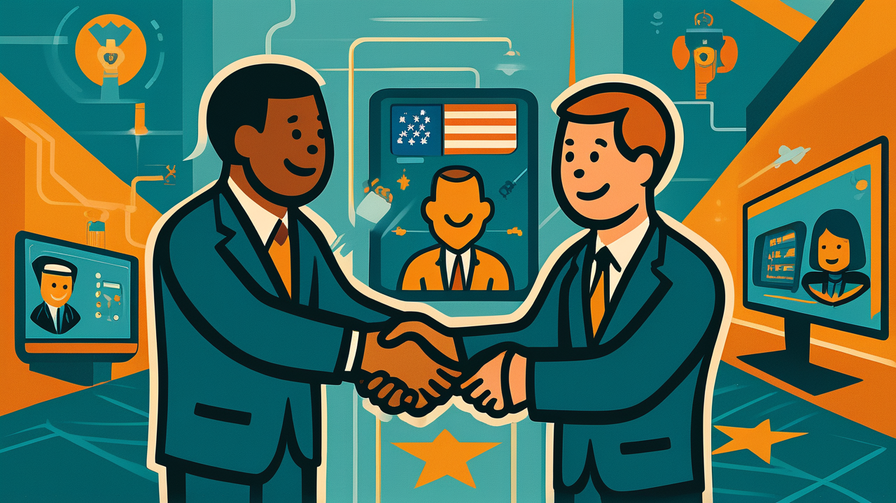[Disclaimer] This article is reconstructed based on information from external sources. Please verify the original source before referring to this content.
News Summary
The following content was published online. A translated summary is presented below. See the source for details.
President Trump has signed an executive order aimed at promoting the export of American AI technology to allied nations while maintaining strict controls on exports to strategic competitors. The order, titled “Promoting The Export of the American AI Technology Stack,” establishes new guidelines to streamline the approval process for AI exports to trusted partners while strengthening restrictions on exports to nations of concern. The policy recognizes AI as a critical technology for economic and national security, requiring a balanced approach to sharing innovations with allies while protecting American technological advantages. The order directs the Commerce Department to create a “trusted partner” list of nations eligible for expedited AI technology transfers, including NATO allies, Japan, South Korea, and Australia. It also establishes an interagency committee to review AI export applications, ensuring they align with US strategic interests. The initiative aims to strengthen democratic nations’ AI capabilities while preventing authoritarian regimes from accessing advanced American AI technology.
Source: White House News
Our Commentary
Background and Context

AI technology has become as important to national power as oil or nuclear technology once were. Countries with the best AI can have stronger economies, better healthcare, more effective militaries, and competitive advantages in almost every field.
The “American AI Technology Stack” refers to the complete ecosystem of AI tools, from basic chips and software to complete AI systems. Think of it like LEGO blocks – America makes some of the best blocks (chips, algorithms, data tools) that others can use to build their own AI creations.
Currently, the US leads in many AI areas, but China is catching up fast. This creates a dilemma: sharing technology helps allies and brings profits, but it could also help competitors if not carefully controlled.
Expert Analysis
This executive order tries to solve a tricky puzzle: how to share AI with friends without helping potential adversaries. It’s like having a secret recipe – you want to share it with family but not with competing restaurants.
The “trusted partner” approach makes sense strategically:
• Strengthens alliances: Helps democratic nations stay technologically competitive
• Creates standards: US and allies can shape how AI is used globally
• Economic benefits: Opens markets for American AI companies
• Security cooperation: Allies using similar AI can work together better
The restrictions on certain nations reflect concerns that AI could be used for surveillance, military purposes, or human rights violations. This is especially relevant given AI’s dual-use nature – the same technology that helps doctors can also power weapons.
Additional Data and Fact Reinforcement
The stakes are enormous:
• The global AI market is projected to reach $1.8 trillion by 2030
• US AI exports were worth approximately $15 billion in 2024
• China invests an estimated $150 billion annually in AI development
• Allied nations represent 65% of global GDP – a huge market
• AI could add $15.7 trillion to the global economy by 2030
For American companies, easier exports to allies could mean massive growth opportunities while maintaining technological leadership.
Related News
This order follows other recent AI initiatives. The CHIPS Act invested $52 billion in semiconductor manufacturing. The AI Safety Institute was created to test AI systems. NATO established an AI strategy for defense cooperation.
Other nations are forming their own AI alliances. The EU’s AI Act creates common rules for member states. The Quad nations (US, Japan, India, Australia) are coordinating AI development. Even smaller nations like Singapore and Israel are becoming AI hubs.
Summary

The executive order on AI exports represents America’s attempt to maintain technological leadership while strengthening democratic alliances. By making it easier to share AI with trusted partners and harder for adversaries to access it, the US aims to shape the global AI landscape. For students interested in technology, international relations, or business, this highlights how technical innovation intersects with global politics. The policy could accelerate AI development in allied nations while potentially widening the technology gap with others. Understanding these dynamics will be crucial as AI increasingly shapes our world.
Public Reaction
Tech companies generally support the order, seeing new market opportunities, though some worry about the bureaucracy of export controls. Allied nations have welcomed increased access to American AI technology. Privacy advocates express concern about AI proliferation without global governance standards. Some experts warn that overly strict controls might push nations to develop their own AI rather than relying on American technology.
Frequently Asked Questions
Q: What exactly gets exported when we talk about AI technology?
A: This includes AI software, specialized chips for AI processing, development tools, trained AI models, and technical knowledge. It’s not just one product but an entire ecosystem of technologies.
Q: Why can’t we just sell AI to everyone?
A: AI can be used for harmful purposes like mass surveillance, autonomous weapons, or spreading disinformation. Controlling exports helps ensure the technology is used responsibly.
Q: How does this affect regular people?
A: If you use products from allied nations, they might improve as they gain access to better AI. It could also create more jobs in the US AI industry as export markets expand.


